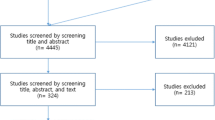Abstract
The use of Radio Frequency Identification (RFID) in the pharmaceutical industry has grown in recent years. The technology has matured from its specialized tracking and retail uses to a systemic part of supply chain management in international pharmaceutical production and distribution. Counterfeit drugs, however, remain a significant challenge for governments, pharmaceutical companies, clinicians, and patients and the use of RFID to track these compounds represents an opportunity for development. This paper discusses the medical, technological, and economic factors that support widespread adoption of RFID technology in the pharmaceutical industry in an effort to prevent counterfeit medicines from harming patients and brand equity.
Similar content being viewed by others
References
Blossom DB, Kallen AJ, Patel PR, Elward A, Robinson L, Gao G, et al. Outbreak of adverse reactions associated with contaminated heparin. N Engl J Med. 2008;359:2674–84.
Kelesidis T, Kelesidis I, Rafailidis PI, Falagas ME. Counterfeit or substandard antimicrobial drugs: a review of the scientific evidence. Journal of Antimicrobial Chemotherapy. 2007;60:214–36.
Rentz ED, Lewis L, Mujica OJ, Barr DB, Schier JG, Weerasekera G, et al. Outbreak of acute renal failure in Panama in 2006: a case–control study. Bull. World Health Organ. 2008;86:749–56.
Akinyandenu O. Counterfeit drugs in Nigeria: A threat to public health. African Medical Journal. 2013;7:2571–2516.
The Economist. Fake pharmaceuticals: Bad Medicine [Internet]. 2012 [cited 2014 Apr 17]. Available from: http://www.economist.com/node/21564546/
World Health Organization. Growing threat from counterfeit medicines. Bull. World Health Organ. 2010;88:247–8.
Lemonde-San F. Corporate Social Responsbility: Sanofi fights against counterfeit medicines. Sanofi; 2013 Jun.
Mackey TK, Liang BA. Improving global health governance to combat counterfeit medicines: a proposal for a UNODC-WHO-Interpol trilateral mechanism. BMC Medicine. BMC Medicine; 2013;11:233.
Shah N. Pharmaceutical supply chains: key issues and strategies for optimisation. Computers & Chemical Engineering. 2004;28:929–41.
Yong W, Andrechak G, Lou J, Riben M. A review of radio frequency identification technology for the anatomic pathology or biorepository laboratory: Much promise, some progress, and more work needed. J Pathol Inform. 2011;2:34.
Agrawal YK, Shah R, Prajapati P. Anticounterfeit packaging technologies. J Adv Pharm Tech Res. 2010;1:368.
Stanford V. Pervasive computing goes the last hundred feet with RFID systems. Pervasive Computing. 2003;2:9–14.
Attaran M. RFID: an enabler of supply chain operations. Supply Chain Management: An International Journal. 2007;12:249–57.
Collins J. Purdue Pharma tags OxyContin. RFID Journal. 2004; November.
Krivda C. RFID: After Compliance - Integration and Payback. Businessweek. 2004 Nov 30.
Yao W, Chu C-H, Li Z. The Adoption and Implementation of RFID Technologies in Healthcare: A Literature Review. J Med Syst. 2011;36:3507–25.
Reuters. Fake batches of Eli Lilly drug Zyprexa found in UK [Internet]. 2007 [cited 2014 Apr 25]. Available from: http://www.reuters.com/article/2007/05/25/idUSL2446370820070525
Japsen B. Baxter loses first Heparin case. Chicago Tribune [Internet]. Chicago; 2011 Jun 9. Available from: http://articles.chicagotribune.com/2011-06-09/business/chi-baxter-loses-first-heparin-case-20110609_1_baxter-heparin-animallike-substance-scientific-protein-laboratories
Howard JD. Implementation of RFID in the pharmaceutical industry. Singh J, editor. California Polytechnic State University; 2009.
Coustasse A, Tomblin S, Slack C. Impact of radio-frequency identification (RFID) technologies on the hospital supply chain: a literature review. Perspect Health Inf Manag. 2013;10:1d.
Christe B. Evaluation of current literature to determine the potential effects of radio frequency identification on technology used in diabetes care. J Diabetes Sci Technol. 2009;3:331–5.
Castro L, Lefebvre E, Lefebvre LA. Adding Intelligence to Mobile Asset Management in Hospitals: The True Value of RFID. J Med Syst. 2013;37:9963.
Sugita M, Miyakawa M. Economic analysis of use of counterfeit drugs: health impairment risk of counterfeit phosphodiesterase type 5 inhibitor taken as an example. Environ Health Prev Med. 2010;15:244–51.
Author information
Authors and Affiliations
Corresponding author
Additional information
This article is part of the Topical Collection on Systems-Level Quality Improvement
Rights and permissions
About this article
Cite this article
Taylor, D. RFID in the Pharmaceutical Industry: Addressing Counterfeits with Technology. J Med Syst 38, 141 (2014). https://doi.org/10.1007/s10916-014-0141-y
Received:
Accepted:
Published:
DOI: https://doi.org/10.1007/s10916-014-0141-y



